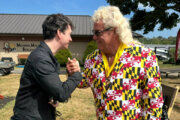Mark in Olney writes: “Every year we have bees digging in our grass. They come out of the ground and swarm around bushes and flowers late July through September and make ant-like dirt hills in the lawn. How can we get rid of them?”
No matter what they are …
The basic answer is to take better care of your lawn.
A surprising number of species of native and imported “digger” bees and wasps can make little individual ground-based nests in our region, but all of them prefer lawns with bare spots. Sometimes these ratty areas are caused by excessive shade; often it’s from “scalping” — cutting the grass too low. (Three inches of green should always be left standing after mowing.)
But one overlooked cause is failure to overseed clumping grasses such as fescue. These grasses can’t creep along the ground and need to have their bare spots re-seeded (or “overseeded”) every couple of years in the fall. (This is not a character flaw; fescues are great grasses, but they don’t spread to fill in their own bare spots like bluegrass, zoysia and Bermuda do.)
If there are bare spots in the lawn, there’s still time to spread compost or topsoil over the area and then rake in some matching seed. But time is running out, so don’t delay. (And don’t just throw seed on the ground; give it some nice soil to grow in.)
And in the future, never cut the grass lower than three inches for any reason.
The dirt on digger bees
If Mark’s problem were happening in the spring, the so-called culprits would almost certainly be bees — specifically, solitary ground-nesting native bees.
Those bees may appear in large numbers, but they are not social insects like honeybees and hornets. Each mother bee creates its own little home in which to raise her young. (In the case of the famous “cellophane” or “polyester” bee, each of the little nests is lined with a waterproof material that looks like plastic wrap.)
These native bees are very gentle. In 30 years in the business, I’ve never heard a report of them stinging anyone. They are almost as ephemeral as tulips and daffodils, appearing and disappearing very quickly in the spring. And they are superb pollinators, often hard at work before (imported) honeybees are up and out of their hives for the season.
So do build up the lawn if you want them to nest elsewhere in the future, but please don’t attack them directly. They won’t sting you but will dramatically increase the amount and quality of food and flowers in your landscape.
And with honeybees famously on the ropes, we need our native bees more than ever.
But we think Mark has wasps, not bees
Many species of native bees will make these kinds of small, individual ground nests in the spring. Again, such “digger bees” are very gentle and great pollinators of food and flowers. But in the summer a solitary flying insect living in what looks like an anthill is more likely to be a ground-nesting wasp.
(And not a yellow jacket. These dangerous insects do nest in the ground, but all of the members of a nest use the same hole, are terrifyingly aggressive and don’t kick up dirt because they can’t dig.)
One big candidate for the cause of Mark’s situation is the large and fearsome-looking cicada killer wasp. The females of this species capture live cicadas, sting them, drag the massive pieces of prey to individual holes the wasp has dug in the ground, and then lay their eggs in the hole before covering it up. You can guess what happens next: bad day for the cicada.
But I think Mark may instead be enjoying the company of a member of the scarab wasp family, a very large genus that has members worldwide. The blue-winged wasp is the most common in our area, and the behavior is exactly as Mark describes.
Although both kinds of wasps are large and do have stingers, they won’t use them unless they’re provoked. Last summer, I walked right through a large swarm of blue-winged wasps at a community garden established by The Salvation Army without a sting, not even a sign of aggressive behavior.
And the blue-winged wasp is a lawn owner’s best friend!
Those ‘digger bees’ are eating beetle grubs!
Female wasps make those mounds when they go into the soil after grubs. All kinds of nasty grubs — June beetle grubs, the larval stages of rose chafer and Asiatic beetles … but their specialty is the Japanese beetle grub that would otherwise eat away the roots of your turf. (The wasps and their prey are all native to Japan.)
The female wasps can sense the grubs in your soil and will dig down and sting every grub they can find. In most cases, the female will then also lay her eggs inside of or next to the disabled grub. But not always. These wasps kill many more grubs than they actually use for baby food. (When eggs are laid, of course, the baby wasps emerge and feed on the grub.)
Either way, the damaged grub never gets to grow up to be a rose-ravaging beetle.
These wasps, which are not interested in stinging people or pets, are getting rid of lots of beetle grubs in your lawn. In the future, better lawn care will lead to fewer grubs, which will mean fewer wasps.
But right now, you should be applauding!
Don’t let fabulous fall leaves go to waste
The leaves now falling on your landscape are not a nuisance. They are all the natural mulch and fertilizer you need to have a great garden.
If you have a lot of leaves falling on your lawn, run them over with a bagging mower, which will shred and collect them for you. If you only have a few leaves falling on the turf, remove the bag and mulch those leaves right back into the lawn, where they will feed the grass and battle thatch. (But whatever you do, don’t let whole leaves lay on a lawn!)
Use a bagging mower or a leaf blower set on reverse (a blower/vac) to suck up, shred and collect the rest of your leaves. Use those shredded leaves as a winter mulch (it’s a much better mulch than any kind of wood), bag up some to save for springtime mulching and/or pour lots of shredded leaves into a big pile or bin to make premium compost.
Whatever you do, don’t rake and toss them. Offer your leaf largesse to a gardening friend. We never have too many leaves!
Mike McGrath was editor-in-chief of Organic Gardening magazine from 1990 through 1997. He has been the host of the nationally syndicated public radio show “You Bet Your Garden” since 1998 and garden editor for WTOP since 1999. Send him your garden or pest control questions at MikeMcG@PTD.net.







